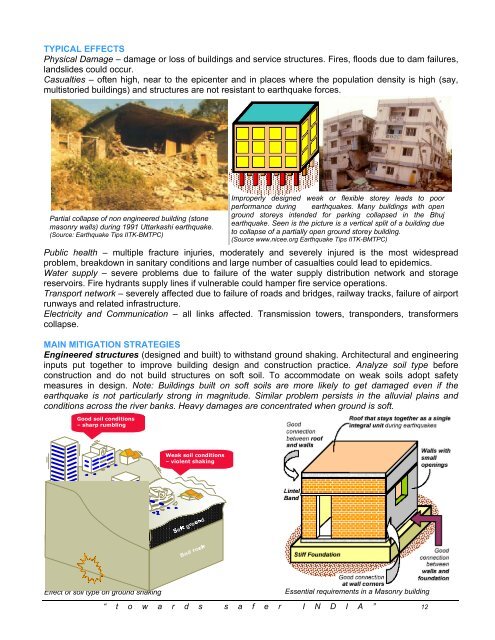Hazards, Disasters And Your Community - United Nations ...
Hazards, Disasters And Your Community - United Nations ...
Hazards, Disasters And Your Community - United Nations ...
Create successful ePaper yourself
Turn your PDF publications into a flip-book with our unique Google optimized e-Paper software.
TYPICAL EFFECTS<br />
Physical Damage – damage or loss of buildings and service structures. Fires, floods due to dam failures,<br />
landslides could occur.<br />
Casualties – often high, near to the epicenter and in places where the population density is high (say,<br />
multistoried buildings) and structures are not resistant to earthquake forces.<br />
Partial collapse of non engineered building (stone<br />
masonry walls) during 1991 Uttarkashi earthquake.<br />
(Source: Earthquake Tips IITK-BMTPC)<br />
Improperly designed weak or flexible storey leads to poor<br />
performance during earthquakes. Many buildings with open<br />
ground storeys intended for parking collapsed in the Bhuj<br />
earthquake. Seen is the picture is a vertical split of a building due<br />
to collapse of a partially open ground storey building.<br />
(Source www.nicee.org Earthquake Tips IITK-BMTPC)<br />
Public health – multiple fracture injuries, moderately and severely injured is the most widespread<br />
problem, breakdown in sanitary conditions and large number of casualties could lead to epidemics.<br />
Water supply – severe problems due to failure of the water supply distribution network and storage<br />
reservoirs. Fire hydrants supply lines if vulnerable could hamper fire service operations.<br />
Transport network – severely affected due to failure of roads and bridges, railway tracks, failure of airport<br />
runways and related infrastructure.<br />
Electricity and Communication – all links affected. Transmission towers, transponders, transformers<br />
collapse.<br />
MAIN MITIGATION STRATEGIES<br />
Engineered structures (designed and built) to withstand ground shaking. Architectural and engineering<br />
inputs put together to improve building design and construction practice. Analyze soil type before<br />
construction and do not build structures on soft soil. To accommodate on weak soils adopt safety<br />
measures in design. Note: Buildings built on soft soils are more likely to get damaged even if the<br />
earthquake is not particularly strong in magnitude. Similar problem persists in the alluvial plains and<br />
conditions across the river banks. Heavy damages are concentrated when ground is soft.<br />
Good soil conditions<br />
– sharp rumbling<br />
Weak soil conditions<br />
– violent shaking<br />
Hypocenter<br />
Effect of soil type on ground shaking<br />
Essential requirements in a Masonry building<br />
“ t o w a r d s s a f e r I N D I A ” 12

















